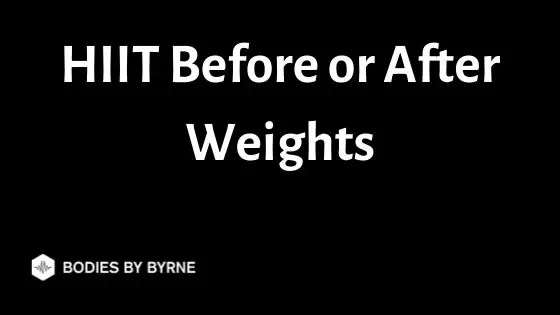High intensity interval training (HIIT) is an explosive style of cardio with a primary focus on fat burning.
Usually, the most common question asked regarding HIIT style training is which is better out of HIIT vs LISS (low intensity steady straight) cardio. This is when it comes to burning body fat or preserving muscle mass however, another common question is whether you can do HIIT and weight training on the same day.
If you can do HIIT and weights on the same day then this leads into the question of whether you can do it before or after weights.
As there are so many variables when trying to decide the best time to do HIIT I thought It best to cover it briefly in this article.
Should you do Hiit before or after weights? HIIT and weight training are not two training styles that work well together due to the muscle glycogen demands of both. Therefore where possible, you should look to do them on seperate days. If that is not an option you should increase the duration as much as possible and do weights before HIIT.
Before getting into it, it’s important to point out that HIIT cardio is a very physically demanding style of training that depletes your muscle glycogen stores (crucial for weight and strength training). Therefore when it comes to optimal progress with your physique I’d say, if possible, schedule your HIIT sessions and weight training session on different days.
I’ll cover some of the key reasons why but if you have the option to separate your HIIT and weight training sessions on different days then this would be best for recovery, performance and ultimately results.
If that isn’t an option for you then don’t worry, I’ll cover the best way to work around that here.
Does HIIT Interfere With Weight Training
HIIT as the name suggests is a high intensity form of cardio that is aimed to burn as much fat as possible whilst being time efficient. I’ve always been good at endurance based cardio however I have a huge preference towards weight training which is why I’ve spent the last 12+ years building muscle as a hobby.
Therefore I’m always of the mental opinion that when it comes to exercise, I’m well prepared. That was until I did my first ever HIIT session at Barry’s Bootcamp.

Now that is a session that puts me in my place whenever I start to think that I’m in ‘good shape’. Therefore I don’t say it lightly when I say that a real HIIT session performed at a high capacity is both demanding and draining.
Weight training can also be demanding and draining and while both of these training styles tax the body in different ways and have different purposes the both inadvertently get fueled by the same energy source which is muscle glycogen.
It can be argued that HIIT is used to primarily utilize fat cells for energy (which is why some people will still do HIIT while bulking) and is the key reasoning behind its use for fat loss however we can’t isolate this process and muscle glycogen is also used to fuel these sessions.
Take a spin class as an example, whilst you are targeting your cardiovascular system, the sprint portions of the spin class are powered by your leg muscles and therefore you are using up a substantial amount of your glycogen stores.
Weight training primarily uses muscle glycogen for muscular contractions and is one of the main reasons that people struggle with strength when on a low carb diet.
Therefore HIIT does interfere with weight training and vice versa, using the same example above if you’ve just performed a leg session then your force output for the spin class will be severely reduced meaning that you can’t actually operate at a “high intensity”.
Can You Do HIIT and Weights on the Same Day
With the above points in mind, if your goal when training is for maximal muscle growth and/or strength then you should look to avoid doing HIIT and weights on the same day entirely.
The energy requirements to do both for optimal results are simply too high to do within such a short space of time. This is why I want to emphasise doing them on separate days where possible, it might be convenient to make one trip to the gym and cover both bases but doing this will yield minimal results.
If you are too fatigued to perform a HIIT session with maximum force then it might be called a HIIT session but it will end up becoming a moderate to low intensity interval session. You might be basing the decision on the best intentions but for optimal progress this choice will do more harm to your progress then it does good.
With that being said, unless you are a professional athlete or bodybuilder then working out is most likely not your number one priority in life so I can accept that a lot of people will want to try and group their cardio and weight training together.
Therefore I’ll point out which method is best so that you can still maximize your progress in the gym and ultimately improve your physique in the long term.
HIIT Before or After Weights
It’s highly recommended that you should always do some form of cardio before your weight training workout in order to raise your heart rate, improve blood flow circulation and basically make sure you are warmed up before getting into your lifting.
I can certainly agree with this approach however HIIT is not the same as a short 10 minute jog on the treadmill and the impact is significantly different. As mentioned HIIT will use muscle glycogen as an energy source as well as fat storage and therefore if you perform HIIT first you will be depleting your muscle glycogen stores.
This is not ideal, especially if your primary goal is muscle growth because now that you have depleted glycogen stores you won’t be able to perform your weights session at maximum capacity.
By maximum capacity I don’t mean beating personal bests on the day (though this might be a goal) but rather it will have a more basic knock on effect. If you can usually do 3 sets of squats for 12 reps at a certain weight then depleting your glycogen stores means you might not be able to match that.
You need to force your body to adapt and grow with progressively heavier weights over time (more reps and sets for an exercise also works) and in order to do this you need to have the energy source available in order to fuel this.
Anyone who has been on a cutting diet will know how difficult it is just to try to maintain strength when carbs and energy levels are low and doing HIIT before your weight training will have a similar impact and leave you feeling weaker because energy stores are depleted.
For any muscle growth and strength related progress I’d therefore recommend that you always start with weight training first (after a light warmup) and place HIIT cardio afterwards. The exception of course is if your primary goal is fat loss and muscle growth is a secondary goal.
In this example, you’d want to target your HIIT session first because just like with weight training and muscle growth you want to give priority to your number one goal. Weight training can then be used to stimulate some protein synthesis and muscle growth but will not detract from your primary goal of fat loss.
These are all however very specific examples and I’d still order it as the following:
HIIT and weights on different days > HIIT after weights (with a 4-8 hour break) > HIIT immediately after weights > HIIT before weights (with a 4-8 hour break) > HIIT immediately before weights
Part of this guideline is influenced by specific studies to show the impact that intense cardio sessions have on strength and the recovery periods needed to support this.
Following that general guideline can be a good process of elimination, if you can’t do the first for lifestyle reasons then move onto the next.
If you are at the end stage then this should be for those who have a primary goal of fat loss and just want to do some weights to engage the muscles and stimulate some protein synthesis.
Hiit After Weights to Burn More Fat
Interestingly, there is a reasoning for doing HIIT after your weights in the pursuit of fat loss and that is because as your muscle glycogen stores are depleted then your body will need to move towards primarily using fat storage as your primary energy source.
There is definitely some sound logic behind this approach and it ties in with my level of priority diagram above very well, though it would slightly change the order of priority meaning you do HIIT immediately after your weight training in order to burn more body fat.
Unfortunately I can’t find any studies to support this theory which I find strange as it would appear to be on the surface a very interesting topic in the pursuit of maximal fat loss which is something everyone wants.
If someone does know of a study that is relevant then it would be great if you could send it over to me at simon@bodiesbybyrne.com as I’d certainly look into it in detail and update this article with any findings.
Instead my best recommendation would be test this out yourself for some anecdotal evidence as the logic is certainly there to suggest that this could be an optimal approach when it comes to scheduling your HIIT cardio around weight training to burn more fat.
Also check out:
Is cardio necessary for cutting
What Next
If you are looking to make changes to your physique by either losing body fat, building muscle or looking to maintain a lean physique then sign up to my weekly newsletter below. Each week I send out actionable tips to help you lose that extra 1lb of fat or build that extra 0.5lb of muscle mass on a weekly basis.
If you sign up now you’ll also receive my 28 day body recomp program completely Free. This ebook will be sent straight to your inbox and will provide an intense 28 day program aimed at helping you lose up to 8lbs of body fat whilst also building 2lb-4lb of lean muscle mass in just 4 weeks.
Don’t worry if you’re not ready for an intense program just yet, my weekly newsletter will give smaller tips that when implemented daily, will stack up over time and see you transform your body with seemingly minimal effort!
